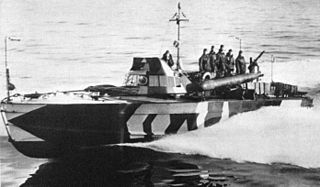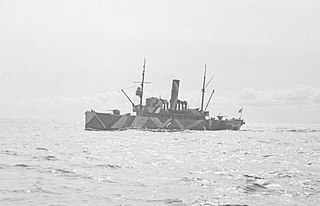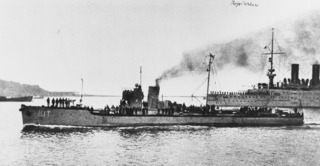
The Finnish Navy is one of the branches of the Finnish Defence Forces. The navy employs 2,300 people and about 4,300 conscripts are trained each year. Finnish Navy vessels are given the ship prefix "FNS", short for "Finnish Navy ship", but this is not used in Finnish language contexts. The Finnish Navy also includes coastal forces and coastal artillery.

The Baltic Sea Campaigns were conducted by Axis and Allied naval forces in the Baltic Sea, its coastal regions, and the Gulf of Finland during World War II. After early fighting between Polish and German forces, the main combatants were Germany and Finland, opposed by the Soviet Union. Sweden's navy and merchant fleet played important roles, and the British Royal Navy planned Operation Catherine for the control of the Baltic Sea and its exit choke point into the North Sea.

Vesihiisi was a Finnish 500-tonne Vetehinen-class submarine that was constructed in the early 1930s. The vessel served in the Finnish Navy during the second World War.

Saukko (Pu110) was a small submarine that served in the Finnish Navy during the Second World War. It was designed not to exceed 100 tonnes, as it was planned for use in Lake Ladoga, and according to the 1920 Treaty of Tartu, no nation was allowed to use naval ships of more than 100 tonnes on the lake. The submarine could be divided into separate sections and transported by rail. The conning tower could be lifted off entirely. The engines were in the aft section and the batteries in the forward section. The name "Saukko" means European otter.

Turunmaa was a Finnish gunboat built in 1918. She served in the Finnish Navy during World War II. The ship was named after Turuma, a type of frigate designed for use in shallow waters of the archipelago and served in the Swedish Archipelago fleet in the late 18th century. The frigates had in turn been named after the region of Finland.

Karjala (ex-Filin) was a Finnish gunboat, built in 1918 at Ab Crichton shipyard in Turku. She served in the Finnish Navy during World War II. Karjala was named after the Finnic cultural region of Karelia. Like her sister ship Turunmaa, she served as cadet training vessel during peacetime and was nicknamed as Kurjala by cadets.

Hämeenmaa was a gunboat that served in the Finnish Navy during World War II. She was built in 1917. As the ship had changed hands many times during the turbulent last years of World War I she had been renamed many times: In Russian service, she was called Pingvin, later, in German service, her name was Wulf. Finally the Germans handed her over to the Finns in 1920, who renamed her Hämeenmaa. After World War II, she served as a trawler in the Baltic Sea. She was scrapped in 1953.

Motoscafo armato silurante, commonly abbreviated as MAS was a class of fast torpedo-armed vessels used by the Regia Marina during World War I and World War II. Originally, "MAS" referred to motobarca armata SVAN (armed motorboat SVAN, Società Veneziana Automobili Navali.
The Hurja class motor torpedo boats or H class was an Italian-designed class of Finnish motor torpedo boats, seeing service with the Finnish Navy during World War II.
The Jymy-class motor torpedo boats or J class was an Italian-designed class of motor torpedo boats, seeing service during World War II with the Italian Navy in Lake Ladoga, and later with the Finnish Navy in the Gulf of Finland.
The Isku-class motor torpedo boat was a Thornycroft type motor torpedo boat of the Finnish Navy. The vessel was constructed in 1926 by the Borgå varv, in Porvoo, Finland, and she saw service in World War II. Isku differed from the original Thornycraft design through its torpedo launching method. However, she was not a successful design and she only participated in the Winter War and during the first months of the Continuation War. She was stricken from the navy lists in 1942, due to extensive wear damage on the hull. She was moored at Suomenlinna and was scrapped after the war.
The Syöksy-class motor torpedo boats was a series of four British Thornycroft type motor torpedo boats of the Finnish Navy. The vessels were constructed in 1928 by the John Thornycroft & Co. shipyard in Woolton, UK. The vessels saw service in World War II. The Thornycroft type released its torpedoes by dropping them from rails in the aft. The ship then had to steer away from the torpedoes path, a manoeuvre that could be quite tricky in the close waters of the Gulf of Finland.

Naval Detachment K was a Finnish military detachment—specifically, a flotilla that operated on Lake Ladoga during World War II.
Finnish Ladoga Naval Detachment was a Finnish naval unit stationed on Lake Ladoga between 1920-1940 and 1941-1944.

The Battle of Someri was a battle in the Gulf of Finland during World War II on 8–9 July 1942, between the Soviet Union and Finland. Starting as a modest operation to clear a Finnish observation post from a small island, it became one of the largest surface ship engagements in the Baltic theater.
The XIIª Squadriglia Squadriglia MAS was a formation of the Italian Royal Navy which served on Lake Ladoga as part of the Axis siege of Leningrad during World War II.

Louhi was a Finnish Navy minelayer. The ship was originally constructed for the Imperial Russian Navy but was taken over by the Finns during the Russian Civil War. She had originally been named Voin, but was renamed as M1 in Finnish service. In 1936 she was given the more personal name Louhi, following the procedure of all other major ships in the Finnish navy.

T1 was a seagoing torpedo boat that was operated by the Royal Yugoslav Navy between 1921 and 1941. Originally 76 T, a 250t-class torpedo boat of the Austro-Hungarian Navy built in 1914, she was armed with two 66 mm (2.6 in) guns and four 450 mm (17.7 in) torpedo tubes, and could carry 10–12 naval mines. She saw active service during World War I, performing convoy, escort and minesweeping tasks, anti-submarine operations and shore bombardment missions. She was part of the escort force for the Austro-Hungarian dreadnought SMS Szent István during the action that resulted in the sinking of that ship by Italian torpedo boats in June 1918. Following Austria-Hungary's defeat later that year, 76 T was allocated to the Navy of the Kingdom of Serbs, Croats and Slovenes, which became the Royal Yugoslav Navy, and was renamed T1. At the time, she and seven other 250t-class boats were the only modern sea-going vessels of the fledgling maritime force.

Sisu was a Finnish state-owned icebreaker. Built in 1939 at Wärtsilä Hietalahti Shipyard in Helsinki, she was one of the world's first diesel-electric icebreakers. In addition to icebreaking duties, she served as a submarine tender for the Finnish Navy during the summer months until the end of the Continuation War.

The Schichau class consisted of 22 torpedo boats built for the Austro-Hungarian Navy between 1885 and 1891. The class was one of the first torpedo boat classes built for the Austro-Hungarian Navy, and they were initially powered by steam from a single locomotive boiler. The entire class was reconstructed between 1900 and 1910, when they received two Yarrow boilers and a second funnel.













